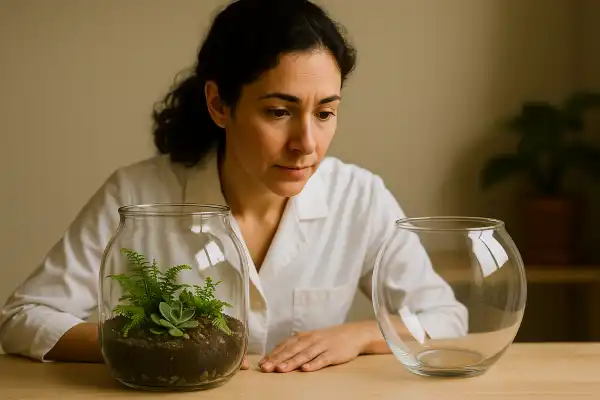How to clean a glass terrarium becomes essential knowledge once you’ve watched your pristine miniature ecosystem develop those stubborn water spots and algae streaks that seem impossible to remove. Every terrarium enthusiast faces this challenge, whether it’s the chalky mineral deposits from tap water misting or the green algae growth that thrives in humid environments.
Building my first closed terrarium six years ago, I remember staring through increasingly cloudy glass, wondering if I’d need to dismantle my carefully crafted ecosystem just to see it clearly again. That frustration led me to develop safe, effective methods that preserve both plant health and crystal-clear viewing.
How to clean a glass terrarium
Clean glass terrarium surfaces using distilled water and microfiber cloths for routine maintenance, with diluted white vinegar solutions for stubborn mineral deposits. The key lies in using gentle, plant-safe methods that won’t disrupt your terrarium’s delicate ecosystem balance.

Understanding terrarium glass contamination
Glass terrariums develop several types of contamination: mineral deposits from tap water evaporation leave white, chalky residue; algae growth creates green films in humid conditions; and organic matter like soil particles or plant debris can create brown or black spots. Each type requires specific approaches while maintaining the pH balance crucial for plant health.
The stubborn, chalky residue typically results from minerals in tap water—when water evaporates, pure H2O disappears but minerals remain deposited on glass surfaces. This explains why prevention through distilled water use proves more effective than frequent deep cleaning.
Essential tools and materials
Gather these plant-safe cleaning tools before starting:
- Microfiber cloths: Leave crystal-clear finishes without white lint residue, unlike paper towels
- Long-handled tweezers: Essential for reaching interior surfaces without disturbing plants
- Distilled water: Prevents future mineral deposits while providing pH-neutral cleaning
- White vinegar: Mix 1 part water to 1 part white vinegar for stubborn mineral deposits
- Soft-bristled brush: For gentle scrubbing without glass scratches
- Lint-free cloths: Use slightly damp, not dripping, to avoid altering water cycles
Step-by-step cleaning process
Exterior cleaning: Start with the outside glass using standard glass cleaner if desired, ensuring no product seeps inside. Clean exterior surfaces using the same gentle methods as interior, though you can apply slightly more pressure.
Preparing for interior cleaning: Wait for afternoon when container walls are almost dry inside. Remove any large decorative elements that might obstruct access, but leave established plants unless absolutely necessary.
Initial dry cleaning: Begin using a soft brush or dry microfiber cloth to gently remove loose dirt or algae, preventing smearing when you introduce moisture. Work systematically around the terrarium, rotating for different viewing angles.
Moist cleaning: Lightly mist interior glass with distilled water, then wipe using microfiber cloth wrapped around long tweezers. Use minimal water to avoid massively altering the established water cycle.
Addressing stubborn deposits: For persistent mineral deposits, apply straight white vinegar, wipe thoroughly, then rinse with distilled water to prevent pH changes. Lemon juice works effectively and safely for calcium removal. As a last resort for thick buildup, carefully use a clean razor blade at 30-degree angle with gentle pressure.
Advanced techniques for closed systems
Create magnetic cleaning tools using microfiber cloth wrapped around strong neodymium magnets—one inside, one outside the terrarium. Exercise extreme caution as dropped magnets can damage plants. Only use on flat surfaces and consider building a small water reservoir on the wall for dipping.
For persistent algae or water marks, diluted hydrogen peroxide can be effective, but use sparingly as large quantities harm plants. Always test solutions on inconspicuous areas first.
Prevention strategies
Use only distilled or reverse osmosis water for misting—it benefits plants and eliminates mineral residue buildup. Position terrariums in bright, indirect light and rotate weekly if light comes from one direction. Maintain proper ventilation for closed systems by opening every few weeks for several hours.
Regular maintenance prevents major cleaning sessions: wipe exterior glass weekly with moistened paper towels without cleaning solutions, and spot-clean interior surfaces monthly using the gentle distilled water method.
Safety considerations
Never use soap, detergents, or commercial glass cleaners inside terrariums—these products cannot escape closed ecosystems and will harm or kill plants. Even natural acids like vinegar and lemon juice require careful pH monitoring. Always rinse thoroughly after using any cleaning solution stronger than plain water.
Remove animals if present before deep cleaning, and check plants for pests before returning them to cleaned environments. Allow all surfaces to dry completely before reassembling your terrarium.
Conclusion
Just last month, I found myself staring through the cloudy glass of my oldest closed terrarium—a moss garden I’d neglected during a busy planting season. Using the gentle vinegar method followed by thorough distilled water rinsing, I restored crystal-clear viewing in under thirty minutes. The delicate ecosystem remained undisturbed, and my miniature landscape once again sparkled under its grow light. This experience reminded me that consistent care prevents major interventions, keeping both our plants and our view of them perfectly clear.
